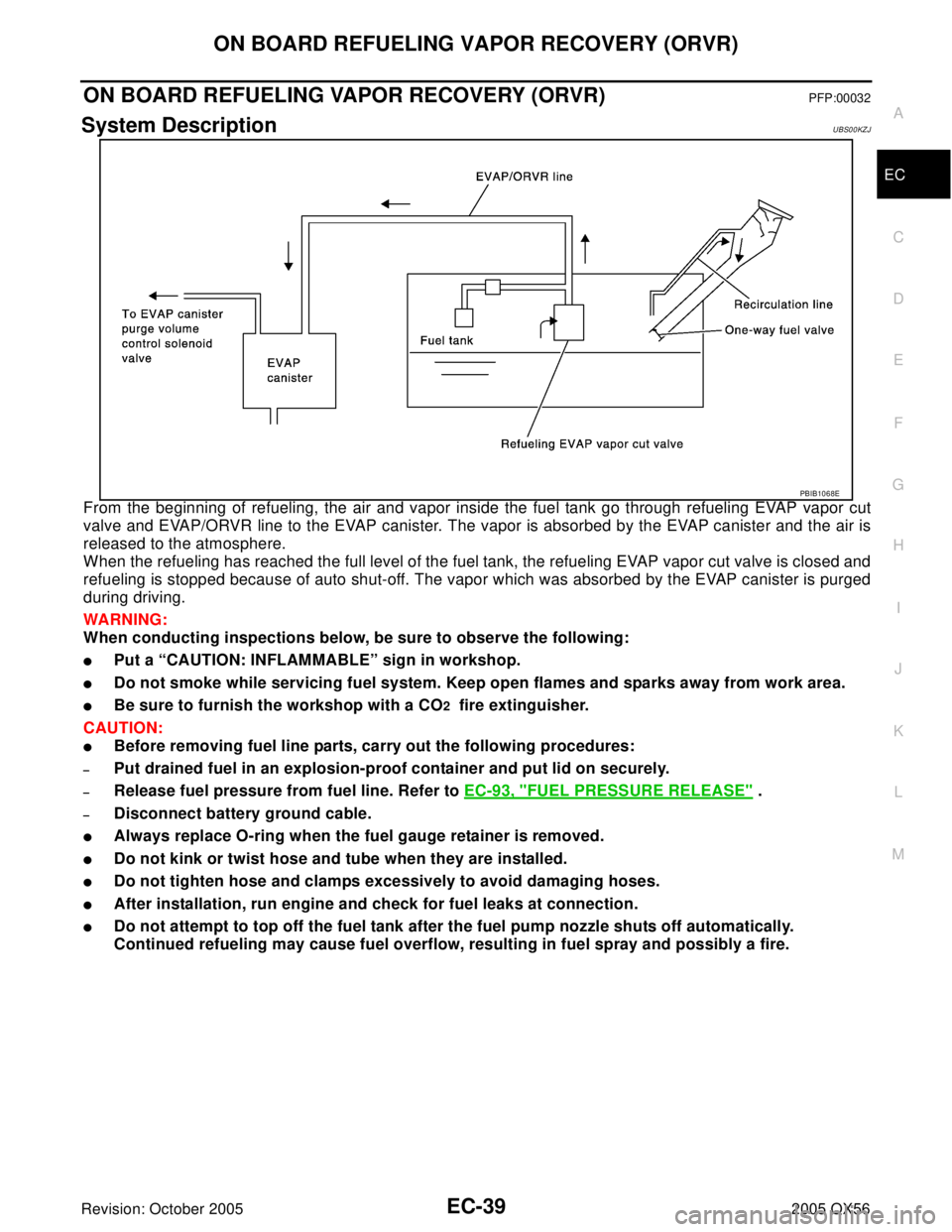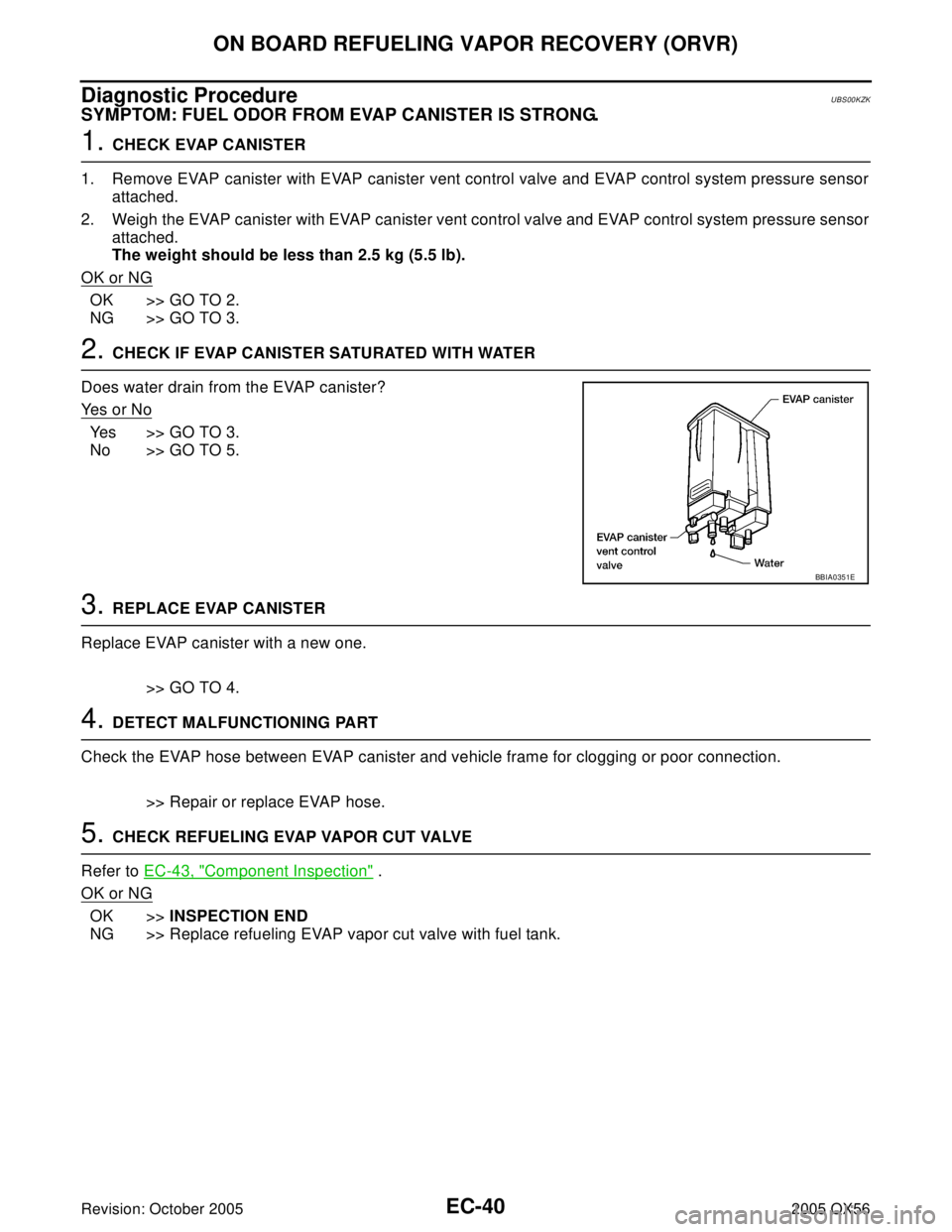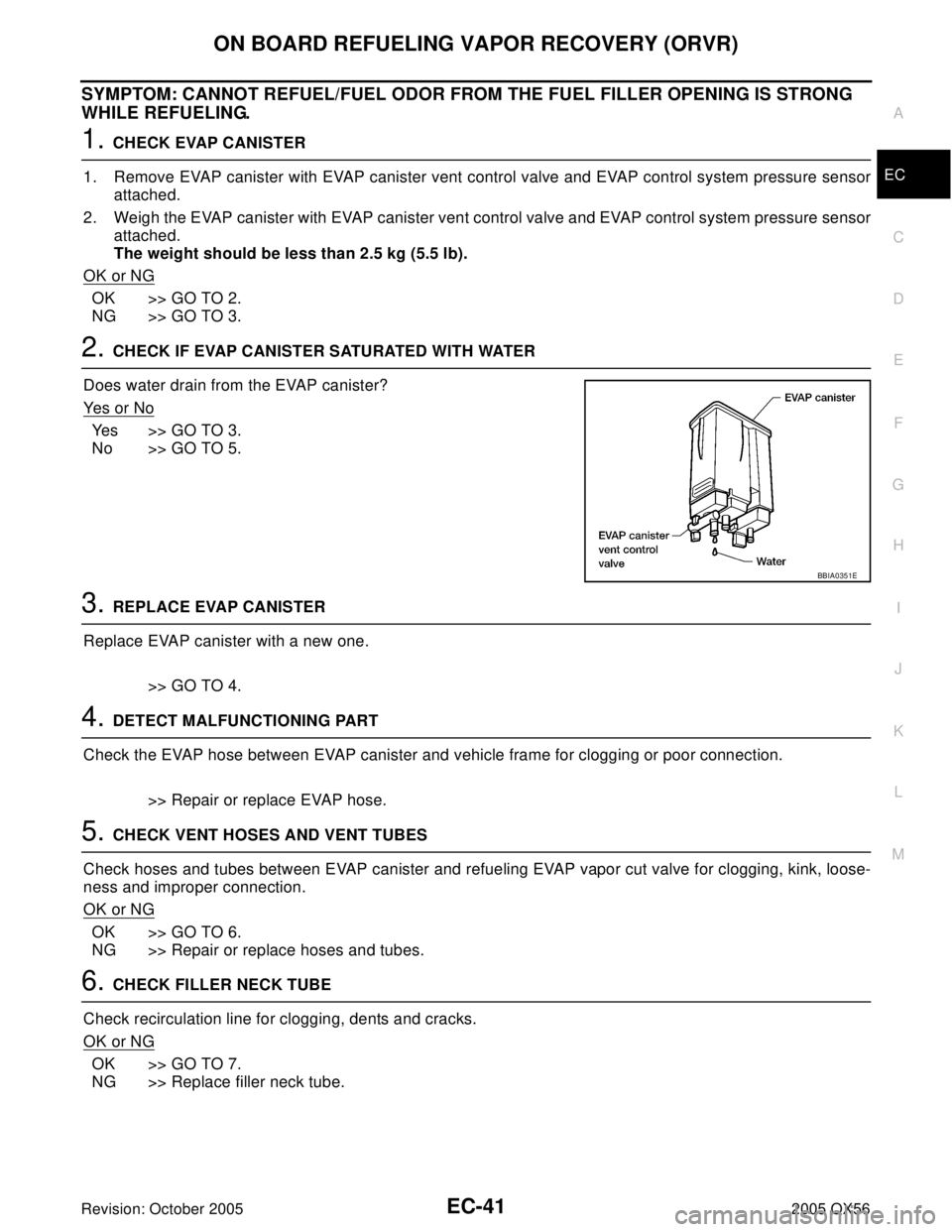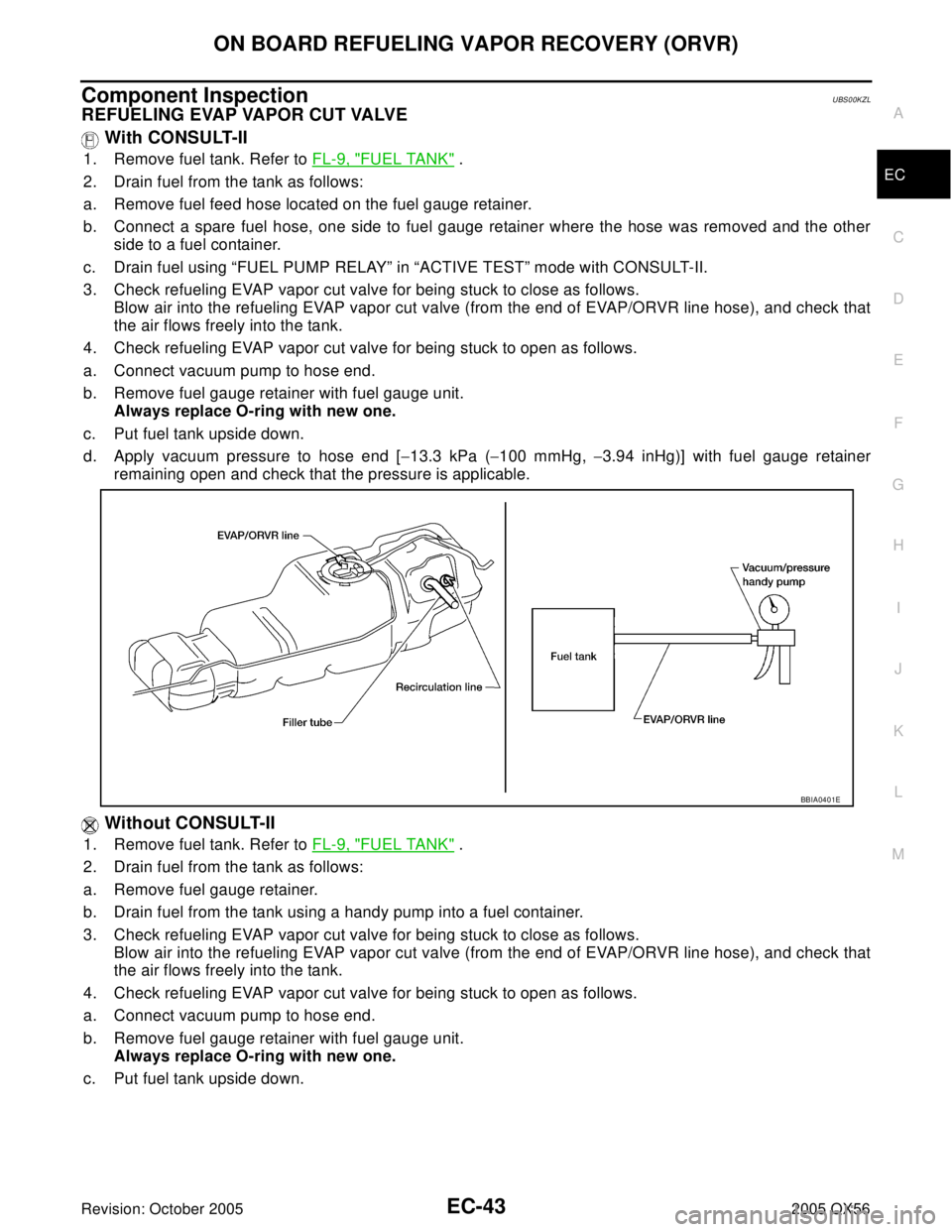Page 1230 of 3419

ON BOARD REFUELING VAPOR RECOVERY (ORVR)
EC-39
C
D
E
F
G
H
I
J
K
L
MA
EC
Revision: October 20052005 QX56
ON BOARD REFUELING VAPOR RECOVERY (ORVR)PFP:00032
System DescriptionUBS00KZJ
From the beginning of refueling, the air and vapor inside the fuel tank go through refueling EVAP vapor cut
valve and EVAP/ORVR line to the EVAP canister. The vapor is absorbed by the EVAP canister and the air is
released to the atmosphere.
When the refueling has reached the full level of the fuel tank, the refueling EVAP vapor cut valve is closed and
refueling is stopped because of auto shut-off. The vapor which was absorbed by the EVAP canister is purged
during driving.
WA RN ING:
When conducting inspections below, be sure to observe the following:
�Put a “CAUTION: INFLAMMABLE” sign in workshop.
�Do not smoke while servicing fuel system. Keep open flames and sparks away from work area.
�Be sure to furnish the workshop with a CO2 fire extinguisher.
CAUTION:
�Before removing fuel line parts, carry out the following procedures:
–Put drained fuel in an explosion-proof container and put lid on securely.
–Release fuel pressure from fuel line. Refer to EC-93, "FUEL PRESSURE RELEASE" .
–Disconnect battery ground cable.
�Always replace O-ring when the fuel gauge retainer is removed.
�Do not kink or twist hose and tube when they are installed.
�Do not tighten hose and clamps excessively to avoid damaging hoses.
�After installation, run engine and check for fuel leaks at connection.
�Do not attempt to top off the fuel tank after the fuel pump nozzle shuts off automatically.
Continued refueling may cause fuel overflow, resulting in fuel spray and possibly a fire.
PBIB1068E
Page 1231 of 3419

EC-40Revision: October 2005
ON BOARD REFUELING VAPOR RECOVERY (ORVR)
2005 QX56
Diagnostic ProcedureUBS00KZK
SYMPTOM: FUEL ODOR FROM EVAP CANISTER IS STRONG.
1. CHECK EVAP CANISTER
1. Remove EVAP canister with EVAP canister vent control valve and EVAP control system pressure sensor
attached.
2. Weigh the EVAP canister with EVAP canister vent control valve and EVAP control system pressure sensor
attached.
The weight should be less than 2.5 kg (5.5 lb).
OK or NG
OK >> GO TO 2.
NG >> GO TO 3.
2. CHECK IF EVAP CANISTER SATURATED WITH WATER
Does water drain from the EVAP canister?
Ye s o r N o
Yes >> GO TO 3.
No >> GO TO 5.
3. REPLACE EVAP CANISTER
Replace EVAP canister with a new one.
>> GO TO 4.
4. DETECT MALFUNCTIONING PART
Check the EVAP hose between EVAP canister and vehicle frame for clogging or poor connection.
>> Repair or replace EVAP hose.
5. CHECK REFUELING EVAP VAPOR CUT VALVE
Refer to EC-43, "
Component Inspection" .
OK or NG
OK >>INSPECTION END
NG >> Replace refueling EVAP vapor cut valve with fuel tank.
BBIA0351E
Page 1232 of 3419

ON BOARD REFUELING VAPOR RECOVERY (ORVR)
EC-41
C
D
E
F
G
H
I
J
K
L
MA
EC
Revision: October 20052005 QX56
SYMPTOM: CANNOT REFUEL/FUEL ODOR FROM THE FUEL FILLER OPENING IS STRONG
WHILE REFUELING.
1. CHECK EVAP CANISTER
1. Remove EVAP canister with EVAP canister vent control valve and EVAP control system pressure sensor
attached.
2. Weigh the EVAP canister with EVAP canister vent control valve and EVAP control system pressure sensor
attached.
The weight should be less than 2.5 kg (5.5 lb).
OK or NG
OK >> GO TO 2.
NG >> GO TO 3.
2. CHECK IF EVAP CANISTER SATURATED WITH WATER
Does water drain from the EVAP canister?
Ye s o r N o
Yes >> GO TO 3.
No >> GO TO 5.
3. REPLACE EVAP CANISTER
Replace EVAP canister with a new one.
>> GO TO 4.
4. DETECT MALFUNCTIONING PART
Check the EVAP hose between EVAP canister and vehicle frame for clogging or poor connection.
>> Repair or replace EVAP hose.
5. CHECK VENT HOSES AND VENT TUBES
Check hoses and tubes between EVAP canister and refueling EVAP vapor cut valve for clogging, kink, loose-
ness and improper connection.
OK or NG
OK >> GO TO 6.
NG >> Repair or replace hoses and tubes.
6. CHECK FILLER NECK TUBE
Check recirculation line for clogging, dents and cracks.
OK or NG
OK >> GO TO 7.
NG >> Replace filler neck tube.
BBIA0351E
Page 1233 of 3419
EC-42Revision: October 2005
ON BOARD REFUELING VAPOR RECOVERY (ORVR)
2005 QX56
7. CHECK REFUELING EVAP VAPOR CUT VALVE
Refer to EC-43, "
Component Inspection" .
OK or NG
OK >> GO TO 8.
NG >> Replace refueling EVAP vapor cut valve with fuel tank.
8. CHECK FUEL FILLER TUBE
Check filler neck tube and hose connected to the fuel tank for clogging, dents and cracks.
OK or NG
OK >> GO TO 9.
NG >> Replace fuel filler tube.
9. CHECK ONE-WAY FUEL VALVE-I
Check one-way valve for clogging.
OK or NG
OK >> GO TO 10.
NG >> Repair or replace one-way fuel valve with fuel tank.
10. CHECK ONE-WAY FUEL VALVE-II
1. Make sure that fuel is drained from the tank.
2. Remove fuel filler tube and hose.
3. Check one-way fuel valve for operation as follows.
When a stick is inserted, the valve should open, when removing
stick it should close.
Do not drop any material into the tank.
OK or NG
OK >>INSPECTION END
NG >> Replace fuel filler tube or replace one-way fuel valve
with fuel tank.
SEF 6 65 U
Page 1234 of 3419

ON BOARD REFUELING VAPOR RECOVERY (ORVR)
EC-43
C
D
E
F
G
H
I
J
K
L
MA
EC
Revision: October 20052005 QX56
Component InspectionUBS00KZL
REFUELING EVAP VAPOR CUT VALVE
With CONSULT-II
1. Remove fuel tank. Refer to FL-9, "FUEL TANK" .
2. Drain fuel from the tank as follows:
a. Remove fuel feed hose located on the fuel gauge retainer.
b. Connect a spare fuel hose, one side to fuel gauge retainer where the hose was removed and the other
side to a fuel container.
c. Drain fuel using “FUEL PUMP RELAY” in “ACTIVE TEST” mode with CONSULT-II.
3. Check refueling EVAP vapor cut valve for being stuck to close as follows.
Blow air into the refueling EVAP vapor cut valve (from the end of EVAP/ORVR line hose), and check that
the air flows freely into the tank.
4. Check refueling EVAP vapor cut valve for being stuck to open as follows.
a. Connect vacuum pump to hose end.
b. Remove fuel gauge retainer with fuel gauge unit.
Always replace O-ring with new one.
c. Put fuel tank upside down.
d. Apply vacuum pressure to hose end [−13.3 kPa (−100 mmHg, −3.94 inHg)] with fuel gauge retainer
remaining open and check that the pressure is applicable.
Without CONSULT-II
1. Remove fuel tank. Refer to FL-9, "FUEL TANK" .
2. Drain fuel from the tank as follows:
a. Remove fuel gauge retainer.
b. Drain fuel from the tank using a handy pump into a fuel container.
3. Check refueling EVAP vapor cut valve for being stuck to close as follows.
Blow air into the refueling EVAP vapor cut valve (from the end of EVAP/ORVR line hose), and check that
the air flows freely into the tank.
4. Check refueling EVAP vapor cut valve for being stuck to open as follows.
a. Connect vacuum pump to hose end.
b. Remove fuel gauge retainer with fuel gauge unit.
Always replace O-ring with new one.
c. Put fuel tank upside down.
BBIA0401E
Page 1235 of 3419
EC-44Revision: October 2005
ON BOARD REFUELING VAPOR RECOVERY (ORVR)
2005 QX56
d. Apply vacuum pressure to hose end [−13.3 kPa (−100 mmHg, −3.94 inHg)] with fuel gauge retainer
remaining open and check that the pressure is applicable.
BBIA0401E
Page 1240 of 3419

ON BOARD DIAGNOSTIC (OBD) SYSTEM
EC-49
C
D
E
F
G
H
I
J
K
L
MA
EC
Revision: October 20052005 QX56
Therefore, when electrical controlled throttle and part of ECM related diagnoses are continuously detected as
NG for 5 trips, ECM warns the driver that engine control system malfunctions and MIL circuit is open by means
of operating fail-safe function.
The fail-safe function also operates when above diagnoses except MIL circuit are detected and demands the
driver to repair the malfunction.
Emission-related Diagnostic InformationUBS00KZR
EMISSION-RELATED DIAGNOSTIC INFORMATION ITEMS
×:Applicable —: Not applicable Engine operating condition in fail-safe mode Engine speed will not rise more than 2,500 rpm due to the fuel cut
Items
(CONSULT-II screen terms)DTC*
1
SRT codeTe s t v a l u e /
Test limit
(GST only)Trip MILRefer-
ence page CONSULT-II
GST*
2ECM*3
CAN COMM CIRCUIT U1000
1000*5—— 1×EC-163
CAN COMM CIRCUIT U1001
1001*5—— 2 —EC-163
NO DTC IS DETECTED.
FURTHER TESTING
MAY BE REQUIRED.P0000 0000———
Flashing*7EC-65
HO2S2 HTR (B1) P0037 0037××2×EC-166
HO2S2 HTR (B1) P0038 0038××2×EC-166
HO2S2 HTR (B2) P0057 0057××2×EC-166
HO2S2 HTR (B2) P0058 0058××2×EC-166
MAF SEN/CIRCUIT P0101 0101 — — 2×EC-174
MAF SEN/CIRCUIT P0102 0102 — — 1×EC-183
MAF SEN/CIRCUIT P0103 0103 — — 1×EC-183
IAT SEN/CIRCUIT P0112 0112 — — 2×EC-191
IAT SEN/CIRCUIT P0113 0113 — — 2×EC-191
ECT SEN/CIRCUIT P0117 0117 — — 1×EC-195
ECT SEN/CIRCUIT P0118 0118 — — 1×EC-195
TP SEN 2/CIRC P0122 0122 — — 1×EC-201
TP SEN 2/CIRC P0123 0123 — — 1×EC-201
ECT SENSOR P0125 0125 — — 1×EC-208
IAT SENSOR P0127 0127 — — 2×EC-211
THERMSTAT FNCTN P0128 0128 — — 2×EC-214
HO2S2 (B1) P0138 0138 —×2×EC-216
HO2S2 (B1) P0139 0139××2×EC-225
HO2S2 (B2) P0158 0158 —×2×EC-216
HO2S2 (B2) P0159 0159××2×EC-225
FUEL SYS-LEAN-B1 P0171 0171 — — 2×EC-236
FUEL SYS-RICH-B1 P0172 0172 — — 2×EC-245
FUEL SYS-LEAN-B2 P0174 0174 — — 2×EC-236
FUEL SYS-RICH-B2 P0175 0175 — — 2×EC-245
FTT SENSOR P0181 0181 — — 2×EC-253
FTT SEN/CIRCUIT P0182 0182 — — 2×EC-259
FTT SEN/CIRCUIT P0183 0183 — — 2×EC-259
TP SEN 1/CIRC P0222 0222 — — 1×EC-264
TP SEN 1/CIRC P0223 0223 — — 1×EC-264
MULTI CYL MISFIRE P0300 0300 — — 2×EC-271
Page 1241 of 3419

EC-50Revision: October 2005
ON BOARD DIAGNOSTIC (OBD) SYSTEM
2005 QX56
CYL 1 MISFIRE P0301 0301 — — 2×EC-271
CYL 2 MISFIRE P0302 0302 — — 2×EC-271
CYL 3 MISFIRE P0303 0303 — — 2×EC-271
CYL 4 MISFIRE P0304 0304 — — 2×EC-271
CYL 5 MISFIRE P0305 0305 — — 2×EC-271
CYL 6 MISFIRE P0306 0306 — — 2×EC-271
CYL 7 MISFIRE P0307 0307 — — 2×EC-271
CYL 8 MISFIRE P0308 0308 — — 2×EC-271
KNOCK SEN/CIRC-B1 P0327 0327 — — 2 —EC-279
KNOCK SEN/CIRC-B1 P0328 0328 — — 2 —EC-279
KNOCK SEN/CIRC-B2 P0332 0332 — — 2 —EC-279
KNOCK SEN/CIRC-B2 P0333 0333 — — 2 —EC-279
CKP SEN/CIRCUIT P0335 0335 — — 2×EC-284
CMP SEN/CIRC-B1 P0340 0340 — — 2×EC-291
TW CATALYST SYS-B1 P0420 0420××2×EC-298
TW CATALYST SYS-B2 P0430 0430××2×EC-298
EVAP PURG FLOW/MON P0441 0441××2×EC-304
EVAP SMALL LEAK P0442 0442××2×EC-309
PURG VOLUME CONT/V P0444 0444 — — 2×EC-318
PURG VOLUME CONT/V P0445 0445 — — 2×EC-318
VENT CONTROL VALVE P0447 0447 — — 2×EC-325
EVAP SYS PRES SEN P0451 0451 — — 2×EC-332
EVAP SYS PRES SEN P0452 0452 — — 2×EC-335
EVAP SYS PRES SEN P0453 0453 — — 2×EC-341
EVAP GROSS LEAK P0455 0455 — — 2×EC-349
EVAP VERY SML LEAK P0456 0456
×*4×2×EC-357
FUEL LEV SEN SLOSH P0460 0460 — — 2×EC-366
FUEL LEVEL SENSOR P0461 0461 — — 2×EC-368
FUEL LEVL SEN/CIRC P0462 0462 — — 2×EC-370
FUEL LEVL SEN/CIRC P0463 0463 — — 2×EC-370
VEH SPEED SEN/CIRC*6P0500 0500 — — 2×EC-372
ISC SYSTEM P0506 0506 — — 2×EC-374
ISC SYSTEM P0507 0507 — — 2×EC-376
PW ST P SEN/CIRC P0550 0550 — — 2 —EC-378
ECM P0605 0605 — — 1 or 2× or —EC-383
TCM P0700 0700 — — 1×AT-103
PNP SW/CIRC P0705 0705 — — 2×AT-104
ATF TEMP SEN/CIRC P0710 0710 — — 2×AT-126
VHCL SPD SEN/CIR AT*6P0720 0720 — — 1×AT- 11 5
TCC SOLENOID/CIRC P0740 0740 — — 2×AT- 11 5
A/T TCC S/U FNCTN P0744 0744 — — 2×AT- 11 7
L/PRESS SOL/CIRC P0745 0745 — — 2×AT- 11 9
Items
(CONSULT-II screen terms)DTC*
1
SRT codeTe s t v a l u e /
Test limit
(GST only)Trip MILRefer-
ence page CONSULT-II
GST*
2ECM*3